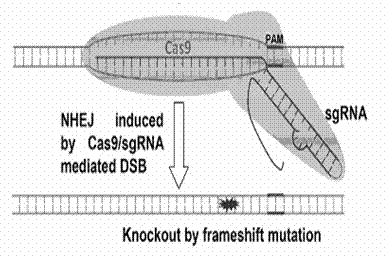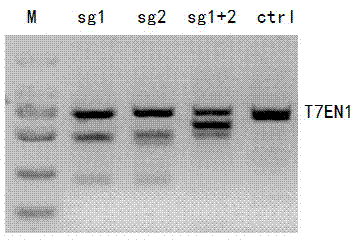Method for specifically knocking out human CCR5 (Chemokine Receptor 5) gene by CRISPR (clustered regularly interspaced short palindromic repeat-associated)-Cas 9 and SgRNA (single guide RNA) for specifically targeting CCR5 gene
A pgl3-u6-hccr5sg, specific technology, applied in the field of genetic engineering, can solve the problems of low efficiency, high cost, time-consuming ZFN, etc., and achieves high efficiency, improved efficiency, and good therapeutic effect.
- Summary
- Abstract
- Description
- Claims
- Application Information
AI Technical Summary
Problems solved by technology
Method used
Image
Examples
Embodiment 1
[0066] Example 1 Design and synthesis of sgRNA for specific targeting of CCR5 gene in CRISPR-Cas9 specific knockout of human CCR5 gene
[0067] 1. Design of sgRNA targeting human CCR5 gene:
[0068] (1) Select the 5'-GGN(19)GG sequence on the CCR5 gene. If there is no 5'-GGN(19)GG sequence, 5'-GN(20)GG or 5'-N(21)GG is also Can.
[0069] (2) The target site of sgRNA on the CCR5 gene is located in the exon of the gene, which is more likely to cause the deletion of the fragment or the frame shift mutation, so as to achieve the purpose of complete gene inactivation.
[0070] (3) The targeting sites of sgRNA on the CCR5 gene are located on the common exons of different splicing forms.
[0071] (4) Use BLAT in the UCSC database or BLAST in the NCBI database to determine whether the target sequence of the sgRNA is unique and reduce potential off-target sites.
[0072] According to the above method, we designed a total of 100 sgRNAs targeting the human CCR5 gene, and the ...
Embodiment 2
[0089] Example 2 Using CRISPR-Cas9 to specifically knock out the human CCR5 gene (the sgRNA used to target the CCR5 gene is shown in Sequence Table 53)
[0090] 1. Linearization sequence such as sequence table SEQ ID NO. 6 The indicated pGL3-U6-sgRNA plasmids.
[0091] Enzyme digestion system and conditions are as follows:
[0092] 2 μg pGL3-U6-sgRNA (400 ng / μl);
[0093] 1 μl CutSmart Buffer;
[0094] 1 μl BsaI (NEB, R0535L);
[0095] Add water to 50 μl, incubate at 37°C for 3-4 hours, shake and centrifuge at intervals to prevent droplets from evaporating onto the tube cap.
[0096] After digestion, use AxyPrep PCR Clean up Kit (AP-PCR-250) to purify and recover to 20-40 μl sterilized water.
[0097] 2. The double-stranded sgRNA oligonucleotides obtained after denaturation and annealing that can be connected to the U6 eukaryotic expression vector (the sequences of its Forward oligo and Reverse oligo are respectively as shown in the sequence table S...
Embodiment 3
[0128] Example 3 Using CRISPR-Cas9 to specifically knock out the human CCR5 gene (the sgRNA used to target the CCR5 gene is shown in the sequence table as SEQ ID NO. 58)
[0129] 1. Linearization sequence such as sequence table SEQ ID NO. 6 The indicated pGL3-U6-sgRNA plasmids.
[0130] Enzyme digestion system and conditions are as follows:
[0131] 2 μg pGL3-U6-sgRNA (400 ng / μl);
[0132] 1 μl CutSmart Buffer;
[0133] 1 μl BsaI (NEB, R0535L);
[0134] Add water to 50 μl, incubate at 37°C for 3-4 hours, shake and centrifuge at intervals to prevent droplets from evaporating onto the tube cap.
[0135] After digestion, use AxyPrep PCR Clean up Kit (AP-PCR-250) to purify and recover to 20-40 μl sterilized water.
[0136] 2. The double-stranded sgRNA oligonucleotides obtained after denaturation and annealing that can be connected to the U6 eukaryotic expression vector (the sequences of its Forward oligo and Reverse oligo are respectively as shown in th...
PUM
 Login to View More
Login to View More Abstract
Description
Claims
Application Information
 Login to View More
Login to View More - R&D
- Intellectual Property
- Life Sciences
- Materials
- Tech Scout
- Unparalleled Data Quality
- Higher Quality Content
- 60% Fewer Hallucinations
Browse by: Latest US Patents, China's latest patents, Technical Efficacy Thesaurus, Application Domain, Technology Topic, Popular Technical Reports.
© 2025 PatSnap. All rights reserved.Legal|Privacy policy|Modern Slavery Act Transparency Statement|Sitemap|About US| Contact US: help@patsnap.com



